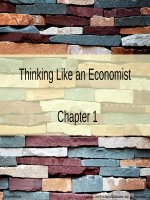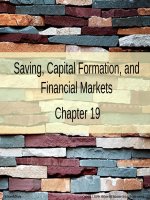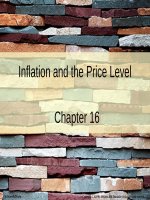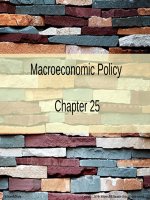Lecture Principles of economics (Asia Global Edition) - Chapter 1
Bạn đang xem bản rút gọn của tài liệu. Xem và tải ngay bản đầy đủ của tài liệu tại đây (791.75 KB, 33 trang )
Thinking Like an Economist
Chapter 1
McGrawHill/Irwin
11
Copyright © 2015 by McGrawHill Education (Asia). All rights reserved.
Learning Objectives
1.
2.
3.
4.
Explain and apply the Scarcity Principle
Explain and apply the Cost-Benefit Principle
Discuss three important pitfalls that occur
when applying the Cost-Benefit Principle
inconsistently
Explain and apply the Incentive Principle
12
The Scarcity Principle
13
The Scarcity Principle:
Examples
14
The Cost-Benefit Principle
•
•
Take an action if and only if the extra benefits
are at least as great as the extra costs
Costs and benefits are not just money
15
Applying the Cost – Benefit
Principle
•
Assume people are rational
–
•
Would you walk to town to save $10 on an
item?
–
–
•
A rational person has well defined goals and tries to
fulfill those goals as best they can
Benefits are clear
Costs are harder to define
Hypothetical auction
–
–
Would you walk to town if someone paid you $9?
If you would walk to town for less than $10, you gain
from buying the item in town
16
Cost – Benefit Principle
Examples
17
Economic Surplus
•
The economic surplus of an action is equal
to its benefit minus its costs
18
Opportunity Cost
•
Opportunity cost is the value of what must
be foregone in order to undertake an activity
–
•
Examples:
–
–
•
Consider explicit and implicit costs
Give up an hour of babysitting to go to the
movies
Give up watching TV to walk to town
Caution: NOT the combined value of all
possible activities
–
Opportunity cost considers only your best
alternative
19
Economic Models
•
Simplifying assumptions
–
–
•
Which aspects of the decision are absolutely
essential?
Which aspects are irrelevant?
Abstract representation of key relationships
–
The Cost-Benefit Principle is a model
•
•
If costs of an action increase, the action is less
likely
If benefits of an action increase, the action is
more likely
110
Three Decision Pitfalls
•
•
Economic analysis predicts likely behavior
Three general cases of mistakes
1.
2.
3.
Measuring costs and benefits as proportions
instead of absolute amounts
Ignoring implicit costs
Failure to think at the margin
111
Pitfall #1
Measuring
costs and benefits
as proportions
instead of
absolute amount
•
•
Would you walk to
town to save $10 on
a $25 item?
Would you walk to
town to save $10 on
a $2,500 item?
112
Pitfall #2
Ignoring implicit
costs
Consider your
alternatives
The value of a mileage
program reward
depends on its next
best use
•
Expiration date
•
Do you have time for
another trip?
•
Cost of the next best
trip
•
–
113
Pitfall #3
Failure to think
at the margin
Sunk costs cannot be
recovered
Examples:
•
Eating at an all-youcan-eat restaurant
•
Attend a second year
of law school
•
–
114
Marginal Analysis Ideas
•
Marginal cost is the increase in total cost from
one additional unit of an activity
–
•
Average cost is total cost divided by the number
of units
Marginal benefit is the increase in total
benefit from one additional unit of an activity
–
Average benefit is total benefit divided by the
number of units
115
Marginal Analysis: NASA
Space Shuttle
# of Launches
Total Cost
($B)
Average Cost
($B/launch)
0
$0
$0
1
$3
$3
$3
2
$7
$3.5
$4
3
$12
$4
$5
4
$20
$5
$8
5
$32
$6.4
$12
§
Marginal Cost
($B)
If the marginal benefit is $6 billion per launch, how many launches
should NASA make?
116
Normative and Positive
Economics
–
Normative economic
principle says how
people should behave
•
Gas prices are too
high
•
Building a space base
on the moon will cost
too much
–
Positive economic
principle predicts how
people will behave
•
The average price of
gasoline in May 2010
was higher than in
May 2009
•
Building a space base
on the moon will cost
more than the shuttle
program
117
Incentive Principle
118
Microeconomics and
Macroeconomics
§
§
Microeconomics studies
choice and its implications
for price and quantity in
individual markets
§
Sugar
§
Carpets
§
House cleaning services
Microeconomics considers
topics such as
§
Costs of production
§
Demand for a product
§
Exchange rates
§
§
Macroeconomics studies
the performance of national
economies and the policies
that governments use to try
to improve that performance
§
Inflation
§
Unemployment
§
Growth
Macroeconomics considers
§
Monetary policy
§
Deficits
§
Tax policy
119
Economics Is Choosing
•
Focus in this course is on a short list of powerful
ideas
–
–
•
Explain many economic issues
Predict decisions made in a variety of
circumstances
Core Principles are the foundation for solving
economic problems
120
Economics Is Everywhere
•
•
There are many things that economics can help
to explain
Economic Naturalist topics
–
–
–
Why is expensive software bundled with PCs?
Why can't you buy a car without air-conditioners?
Drive-up ATMs with Braille
121
Working with Equations, Graphs,
and Tables
Chapter 1 Appendix
122
Definitions
•
•
Equation
Variable
–
–
•
Dependent variable
Independent variable
Parameter (constant)
–
–
Slope
Intercept
123
From Words to an Equation
•
•
Identify the variables
Calculate the parameters
–
–
•
•
Slope
Intercept
Write the equation
Example: Phone bill is $5 per month plus 10
cents per MByte of data used
B = 5 + 0.10 D
124
From Equation to Graph
B = 5 + 0.10 D
–
Draw and label axes
•
•
–
Horizontal is independent variable
Vertical is dependent variable
To graph,
•
•
•
Plot the intercept
Plot one other
point
Connect the
points
B
D
12
8
6
5
C
A
10
30
70
D
125









